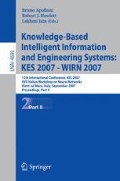Abstract
Unsupervised projection approaches can support Intrusion Detection Systems for computer network security. The involved technologies assist a network manager in detecting anomalies and potential threats by an intuitive display of the progression of network traffic. Projection methods operate as smart compression tools and map raw, high-dimensional traffic data into 2-D or 3-D spaces for subsequent graphical display. The paper compares three projection methods, namely, Cooperative Maximum Likelihood Hebbian Learning, Auto-Associative Back-Propagation networks and Principal Component Analysis. Empirical tests on anomalous situations related to the Simple Network Management Protocol (SNMP) confirm the validity of the projection-based approach. One of these anomalous situations (the SNMP community search) is faced by these projection models for the first time. This work also highlights the importance of the time-information dependence in the identification of anomalous situations in the case of the applied methods.
Access this chapter
Tax calculation will be finalised at checkout
Purchases are for personal use only
Preview
Unable to display preview. Download preview PDF.
References
Laskov, P., Dussel, P., Schafer, C., Rieck, K.: Learning Intrusion Detection: Supervised or Unsupervised? In: Roli, F., Vitulano, S. (eds.) ICIAP 2005. LNCS, vol. 3617, pp. 50–57. Springer, Heidelberg (2005)
Hertz, J.A., Krogh, A., Palmer, R.G.: Introduction to the Theory of Neural Computation. Addison-Wesley, Redwood City, CA (1991)
Friedman, J.H., Tukey, J.W.: A Projection Pursuit Algorithm for Exploratory Data-Analysis. IEEE Transactions on Computers 23(9), 881–890 (1974)
Corchado, E., Herrero, A., Sáiz, J.M.: Detecting Compounded Anomalous SNMP Situations Using Cooperative Unsupervised Pattern Recognition. In: Duch, W., Kacprzyk, J., Oja, E., Zadrożny, S. (eds.) ICANN 2005. LNCS, vol. 3697, pp. 905–910. Springer, Heidelberg (2005)
Zheng, J., Hu, M.: An Anomaly Intrusion Detection System Based on Vector Quantization. IEICE - Trans. Inf. Syst. E89-D(1), 201–210 (2006)
Corchado, E., Fyfe, C.: Connectionist Techniques for the Identification and Suppression of Interfering Underlying Factors. Int. J. Patt. Recogn. Artif. Intell. 17(8), 1447–1466 (2003)
Kramer, M.A.: Nonlinear Principal Component Analysis Using Autoassociative Neural Networks. AIChE Journal 37(2), 233–243 (1991)
Lippmann, R., Haines, J.W., Fried, D.J., Korba, J., Das, K.: Analysis and Results of the 1999 DARPA Off-Line Intrusion Detection Evaluation. In: Debar, H., Mé, L., Wu, S.F. (eds.) RAID 2000. LNCS, vol. 1907, pp. 162–182. Springer, Heidelberg (2000)
Sabhnani, M., Serpen, G.: Application of Machine Learning Algorithms to KDD Intrusion Detection Dataset within Misuse Detection Context. In: 2003 Int. Conference on Machine Learning, Models, Technologies and Applications, pp. 623–630 (2003)
Lee, W., Xiang, D.: Information-theoretic Measures for Anomaly Detection. In: Proc. IEEE Symposium on Security and Privacy (S&P 2001), pp. 130–143. IEEE Computer Society Press, Los Alamitos (2001)
Lee, W., Stolfo, S.J., Mok, K.W.: Mining in a Data-Flow Environment: Experience in Network Intrusion Detection. In: Proc. 5th ACM SIGKDD International Conference on Knowledge Discovery and Data Mining, ACM Press, San Diego, California (1999)
Lee, W., Stolfo, S.J., Mok, K.W.: Adaptive Intrusion Detection: A Data Mining Approach. Artificial Intelligence Review 14(6), 533–567 (2000)
Corchado, E., MacDonald, D., Fyfe, C.: Maximum and Minimum Likelihood Hebbian Learning for Exploratory Projection Pursuit. Data Mining and Knowledge Discovery 8(3), 203–225 (2004)
Seung, H.S., Socci, N.D., Lee, D.: The Rectified Gaussian Distribution. Advances in Neural Information Processing Systems 10, 350–356 (1998)
Rumelhart, D.E., McClelland, J.L.: Parallel Distributed Processing. MIT Press, MA (1986)
Cisco Secure Consulting: Vulnerability Statistics Report (2000)
Herrero, A., Corchado, E., Gastaldo, P., Zunino, R.: A Comparison of Neural Projection Techniques Applied to Intrusion Detection Systems. In: Sandoval, F., Prieto, A., Cabestany, J., Graña, M. (eds.) IWANN’2007. LNCS, vol. 4507, pp. 1138–1146. Springer, Heidelberg (2007)
Herrero, A., Corchado, E., Sáiz, J.M.: MOVICAB-IDS: Visual Analysis of Network Traffic Data Streams for Intrusion Detection. In: Corchado, E., Yin, H., Botti, V., Fyfe, C. (eds.) IDEAL 2006. LNCS, vol. 4224, pp. 1424–1433. Springer, Heidelberg (2006)
Author information
Authors and Affiliations
Editor information
Editors and Affiliations
Rights and permissions
Copyright information
© 2007 Springer-Verlag Berlin Heidelberg
About this paper
Cite this paper
Gastaldo, P., Picasso, F., Zunino, R., Herrero, Á., Corchado, E., Sáiz, J.M. (2007). IDS Based on Bio-inspired Models. In: Apolloni, B., Howlett, R.J., Jain, L. (eds) Knowledge-Based Intelligent Information and Engineering Systems. KES 2007. Lecture Notes in Computer Science(), vol 4693. Springer, Berlin, Heidelberg. https://doi.org/10.1007/978-3-540-74827-4_17
Download citation
DOI: https://doi.org/10.1007/978-3-540-74827-4_17
Publisher Name: Springer, Berlin, Heidelberg
Print ISBN: 978-3-540-74826-7
Online ISBN: 978-3-540-74827-4
eBook Packages: Computer ScienceComputer Science (R0)

